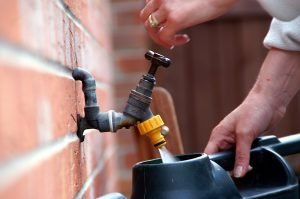
We’re right in the middle of another Great British Summer so we of course should be expecting high temperatures and dry days. After a long, cold winter and a very late spring this year, the summer heat has been exceptional and even though you and I might be loving sitting out in the sunshine or preparing a steak for the barbeque, our gardens need to be managed at this time of year just as much as at other times.
The hard work of preparing our lawns, borders, planters and beds has already been done of course. There should be plenty of colour in your garden by now, garden birds, bee’s and butterfly’s will be plentiful and if you’re lucky you should even catch glimpses of toads, hedgehogs and other small mammals in places.
While it is as hot as it is right now, it’s time to maintain your garden to make sure that it looks it best and stays healthy throughout the summer and well into the autumn so here is our guide to effective watering in this hot period to make sure your garden stays as healthy as you deserve it to be after putting in the hard work so far this year.
When?
It’s best to start watering before the super-high heat kicks in to make sure that your soil is already moist. However, if you missed your chance to do that, it is futile to try and remedy this by light watering over a wide area. Light watering may encourage surface rather than deep roots, leaving plants more susceptible to drought. Instead, make a single thorough watering of the plants that are suffering. After this make sure to water regularly.
The time of the day also matters a lot. Early in the morning or in the evening is best for 2 reasons. Firstly, there is obviously less evaporation of the water that you just used at these times, and secondly, drops of water act as a magnifying glass in direct sunlight so can cause burn damage on leaves, petals and stems.

Choose the right method
Make sure to use the right method of watering. Sprinklers might seem like the easiest method; however, they have only limited use in gardens, mainly to water the lawn and this is not always essential.
Hoses and watering cans are most effective for plants and shrubs, especially those under 5 years old. Most garden watering should be aimed specifically at the stem bases beneath the foliage canopy, leaving the surrounding soil dry. This helps to limit weed problems and ensures all the water goes where it is needed.
Another option that saves time and can direct water only where you want it is a drip or trickle irrigation systems.
Seep hoses or pipes with holes in them deliver water accurately to established plants and plants in rows and can be connected to a simple battery-operated timer so that they only water at specific times of the day.
Keeping your grass great and your plants healthy
If you have an established lawn of at least three years, you don’t need to worry too much about your grass. Grass is very good at dealing with a lack of water, even if it turns brown it will be able to bounce back when the rain return later in the year.
New lawns, however, need a lot of water, especially in the first year as their root system is not sufficiently established to draw up enough moisture to survive dry spells. They will also need extra care, though progressively less, in the second and third year.
Established trees and plants that have been in situ for at least three years do not generally need watering, as they have such wide-ranging roots that they are drought-proof. But their growth may be improved by watering when they are under drought-stress.
Newly sown or newly planted areas are very vulnerable to water-stress, and watering these should be high priority. Herbaceous perennials often need watering to boost their performance in hot, dry spells. Plant choice is crucial if you want to achieve a drought-proof border so it’s worth noting that earlier in the year when planning your beds.
Fruit & Veg yields are greatly improved by watering during drought times, but you should know what crops need watering at certain stages of their development. Leafy produce such as lettuce and spinach should never be short of water. Onions need little or no watering. Most other crops need watering at sowing and transplanting time, and then again as the fruits or roots are developing. It is also a good idea to give a single, thorough watering about two weeks before harvesting.

Don’t be wasteful, conserve and use your water smartly
Mulching with organic matter or even bark or gravel at least 5cm thick prevents moisture loss and can save you time and water not having to irrigate as regularly.
Removing weeds is vital as these unwanted visitors will use up valuable soil moisture rather than your plants or veg.
Install water butts to save rainwater – you’d be amazed how quickly it gathers and gives you free water to use in the garden during dry spells. Or, if you are planning a new garden or can accommodate an underground tank in your garden, why not consider a complete rainwater harvesting system that collects rainwater and pumps it around your garden when it’s needed.
Plan for next year
Remember once again, planning ahead can save you a lot of time and conserve water in dry periods. Begin planting in autumn and spring so that you give plants the best chance of developing their roots early, before they are desperate for watering.
Choose your plants well. If you live in a dry area or are expecting a hotter summer, like many are predicting will become the norm, then choose varieties that need less watering.
The next few months are some of the best in the garden. It’s why you worked so hard all year long to get your garden into the shape it is, so enjoy it while the sun is shining. With a little effort and when you know what you’re doing, you can ensure that you’re able to enjoy your time outdoors even more, for longer this summer.
We at GreenArt can provide help at any level
From planning a wildlife garden, building hides, constructing ponds and streams, creating paths and planting trees and shrubs.








